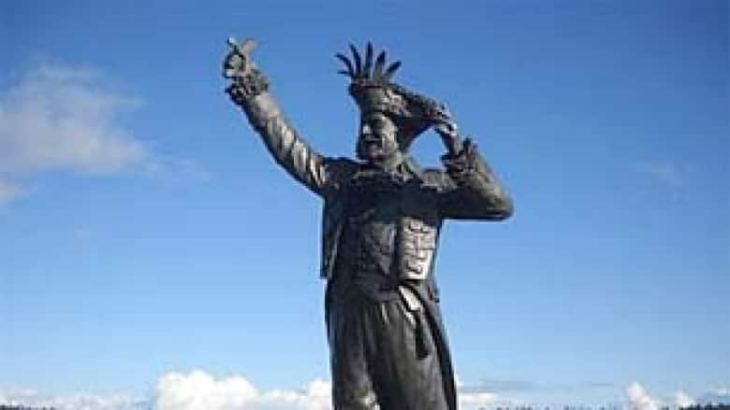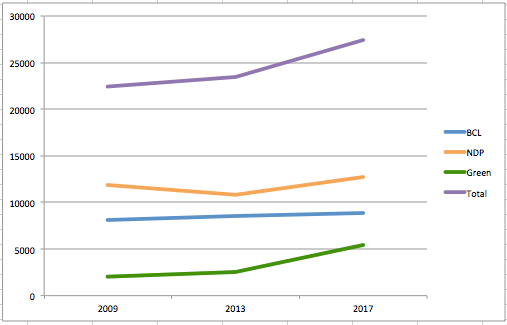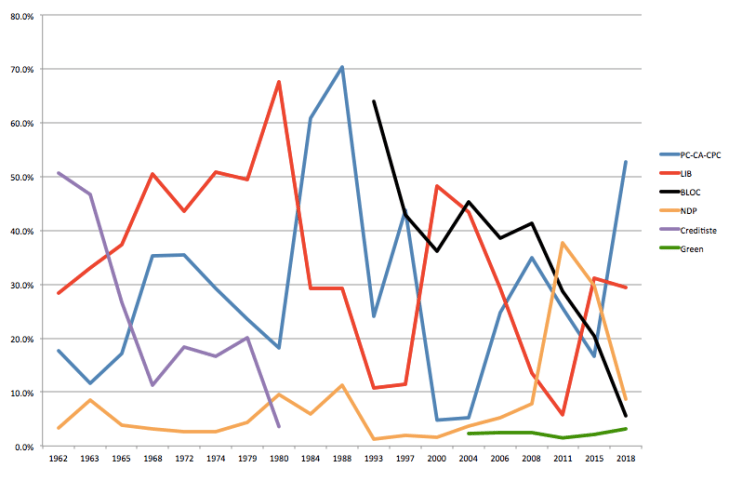Nanaimo NDP MLA Leonard Krog announced his candidacy for Mayor of Nanaimo on Wednesday. If he wins, his resignation as MLA will set up a high stakes by-election that could have a major impact on the government’s razor thin margin in the House.
Nanaimo is a mess and an embarrassment. Whatever the reasons are, the Council has failed to pull themselves together, evidenced by criminal investigations, staff departures, and chaos. The City, renowned for tasty Nanaimo bars and bathtub races, but lately for dysfunctional politics, desperately needs new leadership.

Krog pondering the fate of British Columbia. (Nanaimo News Now)
Leonard is a well-respected elected official who has respect from both sides of the electoral fence. I lived in the area for 15 years and saw Leonard around town a lot – he’s present. He’s well liked. I like him. He’s a good constituency MLA.
The City has a ton of potential. It’s growing, it has an underrated university that does great things, an airport that is one of the fastest growing in Canada, and if someone would please figure out a passenger-ferry link to Vancouver, it would be very attractive for housing-stressed families that work in Vancouver area. It’s a pretty good lifestyle on the mid-Island. It would be even better if the City could get its act together.
It is surprising though that Leonard would seek to leave his post as MLA. When I first heard the rumours of his mayoral candidacy, I rejected them out of hand. Notwithstanding the need in Nanaimo, the NDP have a precarious hold on the Legislature after having endured a sixteen year time-out. I thought there was no way that a by-election could even be contemplated.
Leonard has been serving as MLA since 2005 (and before that he was a government backbencher from 1991-1996). He has 17 years of service, but the call to Cabinet did not come last year. Perhaps, had it not been for Darryl Plecas, he would be Speaker today, and, thus, a central figure in a split Legislature. That opportunity passed him by as well. I’m not sure if any of this factored into his decision, but here we are.
If Leonard wins as mayor and resigns as MLA, the Legislature would then stand at 40 NDP, 3 Green, 42 BC Liberal, and 1 Independent until a by-election fills the seat.
If the BC Liberals win the by-election, they would then have as many MLAs as the combined NDP-Greens, with the Independent Speaker (formerly a BC Liberal) holding the tiebreaker. We can go back a year in time to the exhaustive discussions about how the Legislature will be in gridlock if it is tied. The recruitment of Darryl Plecas relieved that pressure, but losing the by-election makes the situation worse than it was pre-Plecas, especially when the situation would be one of the NDP’s own making.
It should be noted that there already is a strong candidate in the Nanaimo mayor’s race – Don Hubbard. Don is a former chair of Vancouver Island University, a former chair of the Vancouver Island Health Authority, past Citizen of the Year, and an active businessperson in the Nanaimo area. He brings a lot to the table as a mayoralty candidate. While he does not have the profile of Leonard, Nanaimo has only elected one left-leaning mayor (Joy Leach) since the 1960s, and through much of that time, elected a free enterprise pirate. Hubbard is more than capable to be the mayor and could save Horgan the grief of a by-election.

Modern-day Nanaimo Pirate: Is Leonard Krog making John Horgan walk the plank?
If Leonard does win and resign, is there a chance the NDP could lose the by-election?
There are a number of things about the Nanaimo riding to consider.
- Nanaimo is a north-south City. The BC Liberals are strong in the north; the NDP are very strong in the south. A lot of North Nanaimo was previously in the Parksville-Qualicum riding when Judith Reid and Ron Cantelon were the MLAs, but the redistribution prior to 2009 pushed the core Nanaimo seat to the north. This favoured the BC Liberals chances in Nanaimo, but they have not been able to capitalize on that shift. Had former BC Liberal MLA Mike Hunter run on the current boundaries in 2005, he would have been very close to winning the seat. Instead, he lost to Leonard on previous boundaries.
- Prior to 2017, the boundaries were tweaked. It improved the riding yet again for the BC Liberals as some polls in the tough south end were swapped over to Nanaimo-North Cowichan while some good BC Liberal polls were added in. It didn’t help. The BC Liberals did worse in 2017 but that was for other reasons.
- With Leonard, the NDP had a strong candidate with a strong local brand. There is no question he added to the NDP margin. In 2013, BC Liberal Walter Anderson was the 84th of 85 BC Liberal candidates nominated. He was in Hawaii when the campaign started and was recruited by phone. He did a good job and lost to Leonard by only 9.5% – not a huge margin, and won 34 polls, indicating a solid base of support. Had the NDP not had Leonard, had the BC Liberals been more organized, and had the current boundaries been in place, it might have gone to the BC Liberals. Coulda shoulda woulda.
Chart 1: Total votes in Nanaimo riding by Party (2005-2017)

- In 2017, the BC Liberals performed poorly across the entire Island. While Paris Gaudet increased the number of votes for the BC Liberals compared to 2013, turnout increased considerably with the Greens and NDP also growing. The spread between the NDP and BC Liberals grew. Things have changed now. Christy Clark – who had become a lightning rod – has moved on. Andrew Wilkinson is yet to be truly introduced to voters. John Horgan appears strong on the Island but he will not have Leonard on the ballot this time and will have to account for government decisions over the past year.
By-elections in BC suck for governments. Since 1981 when the Social Credit government won a by-election in Kamloops, a sitting government has only won by-elections twice and, in both cases, the candidate’s name was Christy Clark (Point Grey and Westside-Kelowna).
The NDP never lost one of their own seats to a by-election in the 1990s, because no one resigned. In fact, no NDP MLA resigned during the Barrett government either. If Leonard resigns, it will be the first time in BC history that any NDP MLA has resigned his or her seat while an NDP government held power.
While they didn’t have to defend any seats in the 1990s, the NDP were trounced in numerous by-elections, including Parksville-Qualicum in 1998 in which Leonard was a candidate. He had been the MLA in the riding from 1991-1996 but lost in a squeaker to Parksville Mayor Paul Reitsma. Reitmsa disgraced himself over phoney letters to the editor, and other transgressions, and resigned before he could be recalled. What was a slim defeat for Leonard in 1996 mushroomed to a 28-point swing and blowout win for BC Liberal Judith Reid in the 1998 by-election.
One year later, in the Delta South by-election, NDP support plunged from 26% in the previous general election to 2.44%. This may be a record-low in Canada for an incumbent government in a by-election (which can’t be blamed on the candidate, Richard Tones, who dutifully put his name on the ballot). Yes, Millennials, the NDP government really was that unpopular. Is the Horgan government at the same stage as Glen Clark’s government twenty years ago? No. Not even close. But stuff happens and who knows what the next 2, 3, 6 months look like?
(By-elections were not easy for the NDP in the 1990s. In the Matsqui by-election of 1994, the NDP nominated a witch. The witch did not make it to the ballot).
The BC Liberals had their problems with by-elections too. Despite being relatively steady in the polls, the BC Liberals lost a relatively safe seat in Coquitlam – Burke Mountain in a 2016 by-election (a harbinger of things to come). In 2012, during a time of trouble and turmoil early in her premiership, Christy Clark’s government lost two BC Liberal seats, in Port Moody and Chilliwack-Hope. Chilliwack-Hope was truly a safe seat yet voters soundly rejected the government. Is Horgan’s government in the glue as much as Christy Clark’s government was in 2012? No. Not even close. But the 2016 example should give them pause for thought.
Since 1981, there have been twelve by-elections were the government defended its seat and government’s record is 2 wins, 10 losses. Or more precisely, it’s 2 wins for candidate Christy Clark, and 10 wins for the NDP Opposition, which won five by-elections against the Social Credit government between 1984-1989, and five against the BC Liberals between 2004-2016.
Table 1: BC by-elections since 1981 in government held seats

The average swing against the incumbent government of the day since 1981 is 26%, ranging from a massive 59% swing in Surrey-Panorama in 2004 to a 6 point swing in favour of the government in the by-election that elected Premier Christy Clark in Westside-Kelowna in 2013, the only example where the government improved its position.
Since 2008, leaving Christy Clark out of it, the swings range from 14% to 36%.
The high-stakes Point Grey by-election of 2011, won by Christy Clark, had a 7% swing against the BC Liberal government. In hindsight, it was a very risky move to run there.
The swing that is needed for the BC Liberals to win Nanaimo is 15%.
Therefore, the swing required for the BC Liberals to win Nanaimo is on the low end of the spectrum.
If I was an NDP strategist, I would be a little nervous about this. The BC Liberals will be fired up for this opportunity. There will be no shortage of volunteers and money. If the free enterprise base can’t be motivated for a high-stakes by-election like this, then the Party has a deeper problem. I suspect they will rally to support the local campaign, even if the odds are against them.
Finally, it comes down to candidates. Candidates make a big difference in a local campaign. Take Leonard away and the NDP lose support. There is likely not a candidate who is as strong as Leonard available to the NDP.
The BC Liberals must consider carefully their approach too. This is an opportunity and the Party should be beating the bushes, talking to local members and identifying a range of potential candidates.
The Greens say they will run a candidate. They improved their vote in 2017 at no consequence to the NDP. They were also a serious contender in the 2015 federal election in Nanaimo.
As of today, victory still looks like a tall order for the BC Liberals, but not impossible. I estimate, with my gut, that the BC Liberals have a 20% chance of victory. That’s worth fighting for, given the stakes, and given the history of swings against governments in by-elections.
Politics is full of surprises – who would have thought Rachel Notley, Justin Trudeau, Donald Trump, and Doug Ford would be where they are today? Not to mention John Horgan – he didn’t look like a likely prospect 6-12 months before the election.
The NDP sounded confident in the Province newspaper on Sunday. “We’re very confident we would win that by-election,” said an NDP official.
Free advice: don’t take the voters for granted.
Especially ones that travel by bathtub.♦









